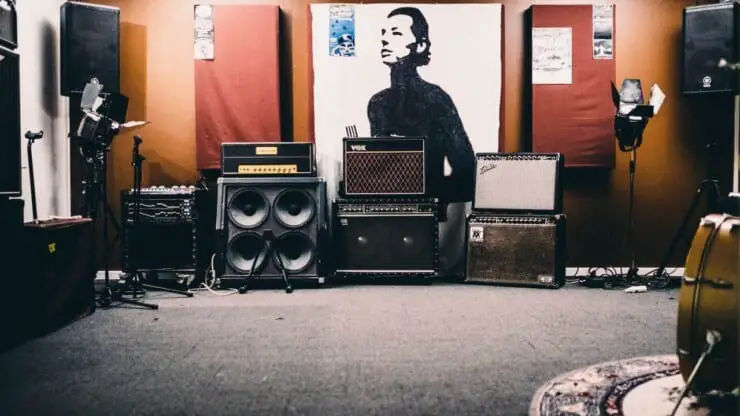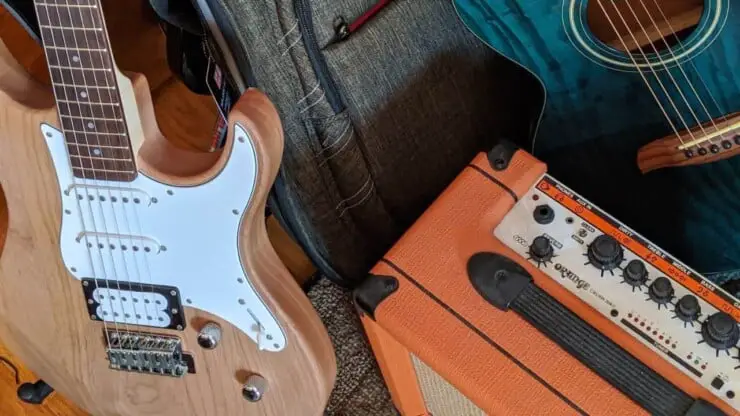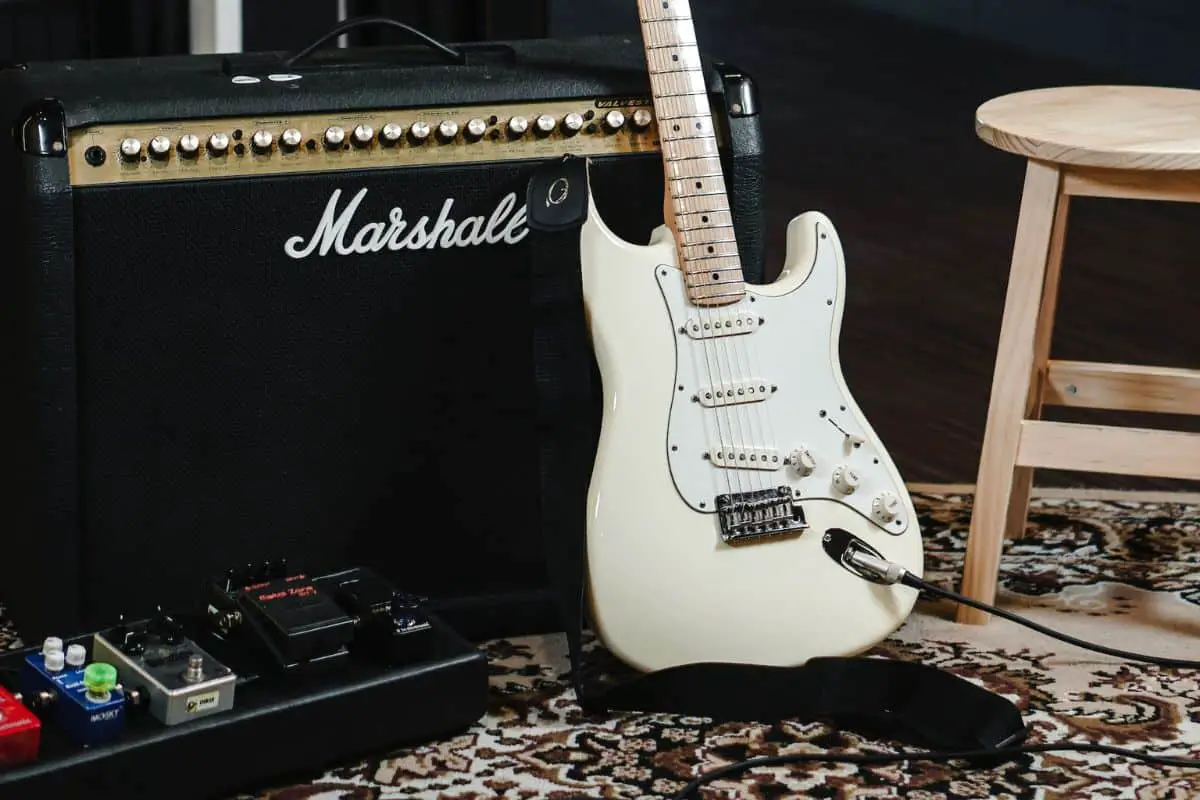Are you planning on buying stereo guitar amps, but don’t know how to ruin two guitar amps in stereo? If so, then you shouldn’t worry, you will know all about it by the time you’re done reading this blog.
Running stereo guitar amps involves chaining two guitar amps together, as the tone splits off at some point in the chain and delivers a different sound out of two sources. Moreover, you will need to choose the right combination of amps to get the best results.
In this article, you’ll get to know all about stereo guitar amps, a breakdown of how to run stereo guitar amps, different combinations of how to run two guitar amps in stereo, and more. Continue reading to get all the answers that you are looking for.
Running stereo guitar amps
Over the past few years, there has been a massive spike in the popularity of stereo guitar amps. This is mostly due to the increase in the quality of digital guitar pedals and amps, allowing guitarists to get studio-like stereo guitar effects with ease. When looking at diving into the world of playing in stereo, it can be quite daunting, with multitudes of methods and results. Before understanding how to run stereo guitar amps, it will be important to look at the basics of what a stereo guitar rig brings to the sound.
A stereo guitar rig can be defined as a setup wherein the guitar tone will split off at some point in the chain to be affected differently. It can then deliver different sounds out of two sources, most likely through two different guitar amps. The easiest way of understanding this would be by thinking of human ears. Humans hear in stereo, i.e. from two ears. For that reason, natural and subconsciously, people prefer the sound of music in stereo rather than mono. It will essentially mirror what you’re familiar with in real life.
There are two parts of the guitar sound that benefit the most from running in stereo –
The primary guitar sound – You’ll have the freedom to amplify and EQ the guitar tone differently each side of the stereo spectrum. It’ll give you enough room for a sonic richness impossible to achieve just by pushing layered sound through an individual speaker.
Modulation effects (reverb, delay, etc.) – The modulation effects were designed for emulating a naturally occurring effect or sound, which can be experienced in stereo. Attempting to recreate it without the stereo spectrum will always leave something missing.
There are two routes that you can take when you go about building a stereo setup – analog and digital.
Analog – This is the original but slightly more expensive route to take. It’s usually done by taking two separate amps and connecting them by way of something known as an ABY pedal. This will allow you to easily split the signal to both amps. This will allow you to add extra effect pedals between your amps and ABY pedal, which grants you endless room for stereo experimentation.
Digital – This is the driving force behind the huge rise in popularity of stereo guitars. Many digital stompboxes and multi-effects pedals have incorporated this processing and provide two separate outputs to send to either a pair of amps or directly to your live PA systems.
There is no legitimate answer for not running a stereo guitar amp in stereo. Some players complain about having to lug around extra gear to shows or technical challenges involved in stereo. When it comes down to it, these arguments are largely based on personal laziness. Everything needs to be in stereo always. Every human having a functional pair of ears will know instinctively that stereo is far better than mono, as real life as stereo. In studio and live contexts, going stereo will enhance power, depth, realism, and dynamics for listeners and players like.
At gigs, the audiences are more appreciative and for guitarists, the sound on stage is infinitely more inspiring. Moreover, they’ll be naturally more immune to variability in terms of quality of monitoring and the mix on stage. Of course, for players that use modulation and delay effects, experiencing tones in full stereo will be powerfully addictive.
Why does wattage matter when running stereo guitar amps?
Ultimately, it’s all about the headroom. The headroom is the amount of clean volume that the amp produces before it starts overdriving. This is due to the fact that they want to run both amp simultaneously at similar gain levels. This way, the sound complements each other. It will be especially important if you are looking to add gain pedals into the mix. If you wish to pair a super high-headroom 100W amp with a low-headroom 1W amp, the moment you step on a distortion pedal, the amp with all its headroom will jump in volume.
Meanwhile, amps with less headroom get pushed over the limit and only produce more gain without an increase in volume. Suddenly, your amps that were perfectly matched in gain and volume get thrown out of balance. One of them ends up becoming much louder and the other one is quieter and more distorted.
Different methods of how to run stereo guitar amps
How exactly does one go stereo? There are multiple ways you can learn how to run stereo guitar amps. Each method comes with its distinct benefits and potential downfalls, which should all be taken into consideration. There are economic factors to remember as well. You should remember that converting a mono guitar setup to stereo often requires gear investment. However, most guitarists already have everything needed, and they only need a few minutes to set it up properly.
The dual amp/cab method
The dual amp/dual cabinet method is one of the best ones for achieving stereo guitar tones. The simple reason for that is that it sounds the best, and it will give the guitarists a wide range of tonal options. Two amps will always be better than one. When using two amps, the power gets increased while the richness of the tone and overall complexity gets enhanced too.
Meanwhile, feedback and musical sustain will be comparatively easier to achieve. Take two guitar amps and then rum them in stereo with stereo delay, modulation pedal, and reverb. The sound will end up becoming fully enveloped while also being a uniquely responsive musical experience.
The simplest way of setting up a dual-amp stereo amp rig would be by using two amps of the same build and model and arranging them in a combo or head-and-cab arrangement. You should use a tuner or effect pedal with stereo outputs or a dedicated ABY box for splitting the guitar signal into two. Then, you should send each signal to its own amp. Using two of the same type of amps is a hassle-free way to do this. It will decrease the likelihood that ground loop issues and phase differences between different amp types will cause difficulties.
The benefit of using two different amp types will be that it’ll allow you to easily blend two distinctly different tones like the mid-range crunch of a Marshall and the scooped thump of a Fender for a more complex and compelling tonal mix.
If ground loop and phase differences do occur, a great solution would be something like the Radial Engineering BigShot ABY. This true bypass, passive ABY switcher pedal comes with a 180-degree polarity reverse for phase-matching amps.
Moreover, there’s an isolation transformer with a ground lift switch to eliminate grounding issues. There are other brands that make numerous amazing switchers with similar functionality, perfect for running stereo amps. If you’re using two of the same amp, then phase differences and grounding issues are unlikely to be a problem. You’ll be able to use a stereo stompbox of any variety for splitting the signal.
Using stereo effects and creating unique tone blends are two of the biggest benefits of the dual amp setup. Essentially, the possibilities with this type of setup are endless. With an ABY switcher, you’ll be able to switch between the amps. Aside from running them at once (using one for dirty sounds and one for clean tones), you can assign each set to a different but complementary EQ setting.
You can even keep an amp completely dry while the other one will handle the effects. You can experiment with physical placement as it can be quite rewarding. Not only that, but you’ll be able to create an extreme stereo spread on stage by moving each amp to a different part of the stage. Kick on a tremolo or delay and wait for the brain-melting psychedelia to ensue.
Another cool trick would be to put a short delay in front of the amp. This will create a type of doubling effect for making the sound wider and more massive. This trick is often employed in recording scenarios for mimicking the effect of a doubled guitar track, and it’ll work equally as well in a live setting.

The single stereo cab method
There are multiple methods to run a rig in stereo using only a single stereo cabinet. These methods will be limited in certain ways than the multi-amp/cab method. You cannot alter the physical spread of the speakers, but they will cut down the amount of gear needed and lugging around any extra amps and cabinets. There are a few possibilities for this type of arrangement. These include a single stereo amp running into stereo 2×12 or 4×12 cabinets, a single stereo combo amp, and two mono heads running into a single stereo cabinet.
Mono/stereo guitar cabs like 1936 2×12 and Marshall 1960 4×12 are rather common. Multiple stereo 2×12 combos like the legendary Roland JC-120 consisting of two separate mono 60W amps in a single chassis or newer stereo designs like the Blackstar ID260TVP are very common. They are an easy solution to get a stereo rig going. Stereo heads are less common as companies make them. Most guitarists choosing stereo into a single cab prefer using two separate mono heads with an ABY switcher or stereo pedal for splitting the signal.
Stereo rack rigs
Many guitarists use stereo guitar amps these days, are using modeling amps. An incredibly popular option includes the Fractal Axe FX II. Meanwhile, many of them also run into a stereo power amp and into one or more speaker cabs. For guitarists who want and need a broad palette of sounds, this will be an effective and simple way of putting together a powerful stereo setup. In such setups, the amp is just providing pure, transparent power instead of the tone. Essentially, any sufficiently robust solid-state stereo power amp will do the job well. These will be far more affordable and widely available compared to guitar heads.
There are more possibilities now than there ever were before for guitarists looking to run their rig in stereo. The creative options that come with such a setup are almost endless. Even guitarists that don’t use a lot in the way of effect can benefit a lot from greater power, girth, and complexity inherent in a stereo guitar setup. Sure, there may be slightly more heavy lifting involved, and setting it up might be more complicated. However, the result will be more than worth the effort. You should resist your lazy tendencies, split the guitar signal, and get the stereo on.
Which guitar amps pair well?
There are different ways you can run a stereo setup. However, the simplest way would be to pick two amps with similar headroom, which generally means similar wattage. However, remember that solid-state and tube amps produce very different volumes and headroom at the same power. As a rule of thumb, a tube amp of 15W or more will have to be paired with a solid-state amp of 50W or more.

As guitar amps are roughly matched in power, it’ll depend on your preference and what type of sound you’re going for. Many guitarists prefer pairing two of the same amp. This is the case, as they like this sound, but they’re simply looking to add more texture and width. Meanwhile, others combine different amps for finding their own unique tone. A great starting point will be to try and pair any of the big three amp brands – Marshall, Fender, and Vox. All three of them will have unique characteristics that complement each other in different ways.
Arguably, the most popular combo will Fender and Marshall. It was popularly used by Simon Neil of Biffy Clyro and Stevie Ray Vaughan. The EQs of the two amps are suited excellently to each other. Fenders are popular for their mid-scooped tone with a lot of bass and top-end sparkle. Meanwhile, Marshalls have a rather mid-focused character that sounds aggressive when cranked up. Together, they’ll fill in where the other one lacks, so you can still get the warmth and chime of the Fender while getting the punch of the Marshall.
Which amps to use when deciding how to run two guitar amps in stereo?
The type of amplification you’re using for a stereo configuration will come down to personal preference as well as experimentation. The general consensus is to use a couple of identical amps and let the effects do their work. If you’re going for two of the same amps, configuring the tone of each amp differently gives a stereo sound. In addition to that, some people prefer using a different set of output tubes for each individual amp. For instance, one amp might contain EL34 tubes while the other might have EL84.
You might also find that combining two different amps can work well. Unless you’ve got an abundance of lying around in your studio, or you have a huge budget, this type of experimenting can be a bit on the pricier side. The relatively cheaper alternative to that will be experimenting with different configurations in amp simulations like the Line 6 POD or the Fractal Audio Axe-Fx. Here are some of the different combinations that you can try.
1. Wet/Wet
This is easily the most common stereo guitar amp setup for home users. It’ll consist of two amps with effects running through both the amps, hence the term “wet/wet”. This guitar rig is rather simple to accomplish, and it can be achieved by using any of the following methods of choice. Any effects pedal including multiple outputs can be used for splitting the mono signal into a right and left output. Moreover, you can use high-quality Y-split cables.
2. A/B or A/B/Y
If you’re looking to have multiple amps for individual purposes, then you’ll probably require an A/B setup. It’ll be great if you want to use one amp for hi-gain and the other for clean sounds. Moreover, this setup is quite effortless to set up, as all you’ll require is an A/B switcher pedal (such as the Boss AB-2). If you’re looking to make good use of both amps simultaneously, you’ll require an A/B/Y pedal (such as the Radial BigShot).
3. Wet/Dry
When you’re using a Wet/Dry setup, it’ll be easy to isolate your effects from the dry signal. It’s an extremely common setup for gigging purposes, as you can send the mixing engineer separate signals with just your effects for more accurate mixing. You’ll be able to maintain a clearer guitar tone without actually adding any extra mud to the dry tone.
This type of setup, alongside the wet/dry/wet setup, is utilized by professional guitarists with a setup that is built by a professional rig builder. However, there’s a simple way of accomplishing this kind of setup at home.
You’ll have to run the “send” from the effects loop of the dry amp into an effects processor such as the TC Electronic G-Major. The output from the effects processor will run into the receiver section of your wet amp. You should ensure that you’re setting the unit to 100% wet and avoiding dry signals getting applied to the effects.
4. Wet/Dry/Wet
It’ll be the same as the wet/dry configuration. However, you’ll also be using an extra amp, which results in the effects being in true stereo. The dry amp will be placed in the center, while the wet amps are placed on either side.
When using the wet/dry/wet configuration, ensure that the PA system at the gig has been configured to stereo. You should remember that the PA systems used in most clubs, restaurants, and pubs are configured in mono. However, it can be argued that the audience is still hearing resemblance to the stereo image created by the on-stage sound if the PA system is configured in mono. You should still carefully think about stereo configuration if the case is a mono PA configuration, as the audio quality will likely be diminished. However, you’ll have to experiment with your particular configurations and rig.
For setting up a wet/dry/wet configuration, you should run the left and right outputs from the stereo effects processor into the “receive” part of the effects loop of each wet amp.
Conclusion
Thank you for reading. Hopefully, now you know a lot more about stereo guitar amps, a breakdown of how to run stereo guitar amps, different combinations of how to run two guitar amps in stereo, and more. Running a stereo guitar amp involves chaining two guitar amps together to produce a better rig. Two amps are always better than one. When using two amps in a setup, the power will be increased, while the overall complexity and the richness of the tone will be enhanced as well. Moreover, the musical sustain and feedback will be much easier to achieve. Ultimately, the most important decision would be to choose the right combination of amps for getting the best results.



